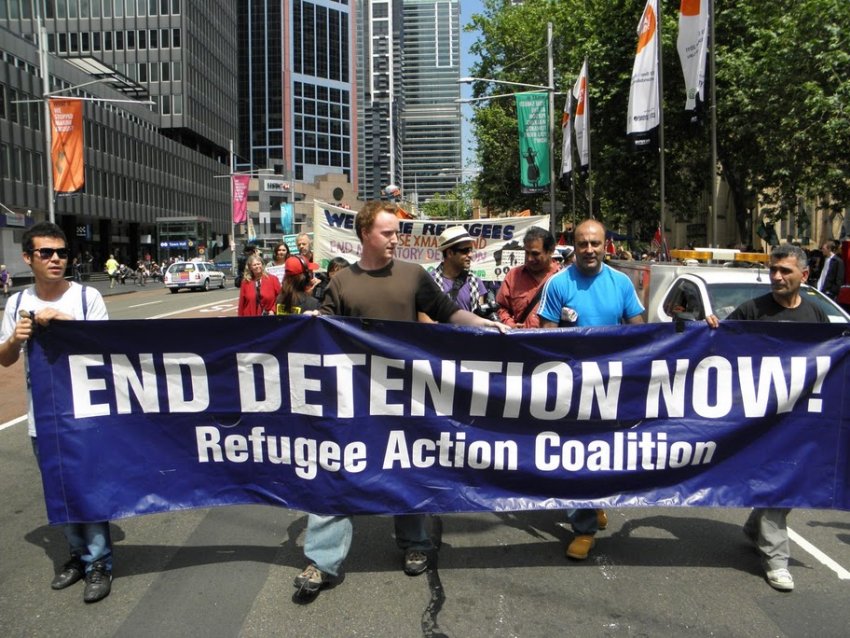
As the federal Labor government was forced to drop its maligned “Malaysia solution” and process all refugees arriving by boat in Australia, there was the hint that its inhumane detention of thousands of refugees would also be questioned.
Immigration minister Chris Bowen said on October 13 that the immigration department may — after health, identity and security checks — give some refugees bridging visas allowing them to live in the community while their claims are assessed.
But he also said there was “some excess capacity in our detention facilities”. And Prime Minister Julia Gillard said the government was still “committed to a mandatory detention system”.
Bowen told MTR Breakfast radio on October 17 that, because some families and children have been moved into “community detention” and “alternative” detention, there was more room to lock up new arrivals.
He also ruled out closing down any detention centres, a key demand of refugee advocates. “I was hoping to close more detention centres if we had the Malaysia arrangement implemented but that’s not possible,” he said (archived by Internet Archive 27/02/2012).
But over the months Labor spent wrestling with the Coalition opposition over which poor country to expel refugees, hundreds of new arrivals have been crammed into a detention system that is already traumatising thousands of innocent people.
About 800 refugees have arrived by boat since the “Malaysia solution” was prematurely signed in July. All have been held at Christmas Island without an assessment of their asylum claims.
Immigration department figures for September 30 showed 4446 men and women seeking asylum in Australia were in detention. There were also 440 children still held in detention facilities and “alternative places of detention”, despite a government promise to stop locking up children.
Bowen’s admission that bridging visas — which are issued to most asylum seekers that arrive by plane — could be used for refugees now in detention centres raises the question of why the crises in Australia's overcrowded detention centres have been able to worsen.
More than 25% of refugees in detention have been locked up for more than a year. Five hundred and thirty four have been held for between 18 months and two years. Fifty six refugees have been held detention for more than two years.
There were 289 acts of self-harm reported in refugee detention centres between July and September, a Senate estimates hearing was told on October 18. Almost half took place at the Christmas Island detention centre, which has struggled with overcrowding for more than two years.
There were a further 639 threats of self-harm and 48 attempts at “serious self-harm”. Six people have died in refugee detention since Labor took government, five of which were suicides.
The hearing also revealed the severe mental health crisis in detention centres, which are now often referred to as “factories for producing mental illness”.
The Canberra Times said: “By September 15, 451 had been diagnosed with a mental illness, while 228 were on anti-psychotic medication and 527 were taking anti-depressant medication.
“Curtin detention centre had the highest rate of mental illness, with 184 people diagnosed, while Northern Immigration Detention Centre [in Darwin] had 125 and Scherger [detention centre in far-north Queensland] had 68.”
Two Kurdish Iranian refugees attempted suicide at the Northern Immigration Detention Centre in Darwin on October 17.
Refugee advocates
Other protests have included protests on the detention centre’s rooftop, prolonged hunger strikes and detainees burying themselves in shallow graves. On September 28, 30 refugees began burying themselves in a hole in the compound.
Further figures released by the government show refugees and Serco staff at the Villawood detention centre in western Sydney are involved in violent incidents at least once a week, the Daily Telegraph said on October 3.
“Staff are involved in more than a third of violent incidents,” it said. “And police are called to it at least every fortnight.”
It has become increasingly obvious that detention centre staff are ill-equipped to cope with the needs of refugees. The latest evidence was a survey submitted by the United Voice union representing Serco staff to a Senate inquiry into detention. It said that while 91.4% of respondents had witnessed self-harm and 82.8% to suicide attempts, 73.7% felt they had inadequate training and 93.9% said detention centres were understaffed.
The Senate inquiry, led by Scott Morrison and Greens Senator Sarah-Hanson Young, has received more than 150 submissions from community, legal, medical, child welfare and human rights groups, most of which were opposed to mandatory detention. Of 1800 emails submitted to the inquiry, more than 1600 were opposed.
Kurdish Iranian and Afghan refugees are carrying out most of the protests, hunger strikes and acts of self-harm. People fleeing Iran and seeking asylum in Australia has risen almost eight-fold since last year, the Sydney Morning Herald said on October 3.
But the number of successful asylum claims by Iranians dropped dramatically from 100% in 2008-09 to just 27% in 2010-11. In June, 611 Iranian refugees were seeking a review of their refugee claim.
Afghan refugees have also faced rising rates of rejection, despite recent UN figures showing Afghanistan had the highest number of people seeking asylum in Western countries.
The new figures, released by the United Nations High Commissioner for Refugees this month, show total refugee numbers are rising around the world — a 17% rise in a year.
High Commissioner Antonio Guterres said on October 18 (archived by Internet Archive 03/02/2012) that 2011 has been “a year of displacement crises unlike any other I have seen in my time as High Commissioner”.
But in Australia, the number of people arriving to claim asylum dropped by 19% in the first half of this year.